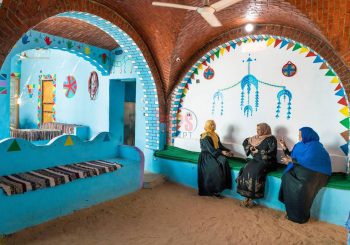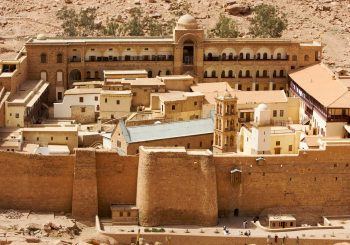Freelancing has become a popular method of a work lifestyle in recent years, as evidenced in the first rendition of the Navigating the Freelance Life in Egypt series focusing on videography and filmmaking.
This lifestyle has been trendy worldwide in the past decade, mostly for its allure of reaching the life many want to live, without stressful work hours and commutes. In Egypt, many question the feasibility of this lifestyle, and many of those who live a freelance work life preach its unsustainability and unpredictability. People’s goals when freelancing can differ, some do it to supplement their regular income, and others do it as their main source of income.
View this post on Instagram
However, in the art and design fields, many say that freelancing is not sustainable alone, due to the low wages and inconsistent barriers of entry.
GETTING STARTED
Menna Afifi has always loved painting, and has been practicing on different materials, documenting everything, and eventually she started an online platform which acted as her art blog and portfolio. One day, she got lucky, and her dentist asked her if she could paint on his new clinic’s walls, and she did. That was how she turned her art into a business.
“As artists, I think the best way, in my opinion, is to find what you specialize in the most and start from there. Experiment with it and never get bored, expose your work everywhere, whenever you get the chance. And throughout each process, document everything with videos, timelapses, and photos, because they will help a lot later when building your own portfolio/brand,” Afifi tells EgyptianStreets.
Afifi also advises never to copy anyone else’s art, “your art should be your art. It has to make you standout so clients would want to come to you.”
View this post on Instagram
How does one manage their time as a visual arts freelancer?
“The time is very manageable, with any freelance work actually, but you’ll need to know what you’re capable of doing! Don’t accept orders with very tight time. For example, I know that I can finish this painting in one week, and if the client wants it earlier than that, I won’t take the order. Art is art after all, you don’t want to make art while stressing out because of deadlines, you have to make it wholeheartedly,” she adds.
What is a good place to start when it comes to rates?
“This honestly differs from one artist to another, depending on the type of art/product you offer. Some measure it per hour, some per meter squared, in both cases you’ll add to that the price for the material/tools used in a profitable way. For example if you decide to get paid X EGP per hour, worked 10 hours on a painting, and the material you used cost Y EGP, then (X*10 hours) + Y. By time and experience you’ll get even better at pricing. Of course, you won’t set very high prices at the beginning, especially that you’re still building your name. However, don’t get underpaid for the effort and work you’ve done! Art takes a lot of effort, time, and material. You are offering a service and a product,” Afifi says.
View this post on Instagram
Sarah Shebl is a graphic designer with speciality in typography who freelances next to her full-time job. Her recent work includes graphic and typographic design for the Azza Fahmy brand.
Why should I even freelance if I have a job?
“Managing your time actually like freelancing with a full time job is difficult but it’s needed, because as I said before, designers are always underpaid so you need to work as a freelancer to increase your income,” she tells Egyptian Streets.
Freelancing also adds to your experience, Shebl says.
“You handle a project from A to Z. And sometimes, you’re forced to do things outside your limits, so you push your limits so you can execute the project. You have the space to experiment and defend your design. In companies, because they have a certain budget, they want to keep their client so usually they stay in the client’s comfort zone and take the safest way so that they guarantee the client. Other times design houses experiment and go wild, like Nastal and Studio Safar in Lebanon. Freelancing allows you to experiment more outside of that with design, and you can easily convince a client. It’s just a pay issue in the market,” she shares.
Why is there a pay issue?
One of the problems facing graphic designers, Shebl says, is that there are people who are unequipped for design work, with software skills but no design skills, who function as graphic designers and price their products very low.
“They charge 200 or 300 EGP for a logo, so that affects us when we ask for the regular fair prices from a client and they refuse because they can get it much cheaper elsewhere. These people kill the graphic design market,” she says.
Shebl adds that this low-cost work is often not quality work, with design mistakes especially when it comes to the Arabic Script, “it ruins the art and design of the country. Therefore, work coming out of Egypt becomes badly designed, because these people haven’t studied design and instead depend on Adobe programs.”
How do you price your work, then?
“I usually prefer working per a package not per hour because sometimes a logo will take a second if it just clicks in your head, and in that case the price will be very low and other times it takes a lot of time if it’s a heavy logo, so it takes many hours which will then cost the client a large amount of money. So, usually the best solution for this is a package price, so you’re not unfair to yourself or the client,” Shebl shares.
What about for animation, are the rates the same?
“The rate depends on the style of the project, so for example a traditional 2D animation project would cost more than a motion graphics video. The measure varies as well, but the most commonly used measure nowadays in animation is per minute,” says Animator Alaaeldin Tawfik.
Is managing your time with a full time job as a freelancer possible?
“I usually try to finish at my working hours exactly whether at five or at six, I then get a break for an hour, usually on my way home on the bus. Then I start to work till 10 PM on whatever freelance work I’m doing. I don’t prefer to work on the weekends, I rarely do, because on the weekend you should recharge. If you don’t recharge, rest, and recover from the exhaustion of the week, there will come a time when you won’t be able to be creative, and you’ll be unable to think and create something original,” Shebl answers.
As an animator, Tawfik shares the same work availability struggle as freelancers in other fields.
“Full-time freelancing can be very tricky, but to me managing time isn’t the challenge, managing the work is. The thing is, freelancers can never be certain when their next project is,” he adds.
While many do say that freelancing is manageable, most agree that freelancing alone is not yet sustainable in Egypt’s current design industry. As Shebl says, working full-time alone as a designer is also generally not a high wage job. However, as more people understand the value of graphic design work and the fair rates, change might be on the horizon for freelancers.
This article is the second in a series Egyptian Streets is producing about freelancing in Egypt. Stay tuned for future articles on freelancing in the fields writing, communication and translation.






Comments (4)
[…] This article is the third in a series Egyptian Streets is producing about freelancing in Egypt. There are other articles for guidance on surviving as a freelance filmmaker as well as a freelance visual artist and designer. […]
[…] The Ultimate Guide to Freelancing in Egypt as an Artist […]